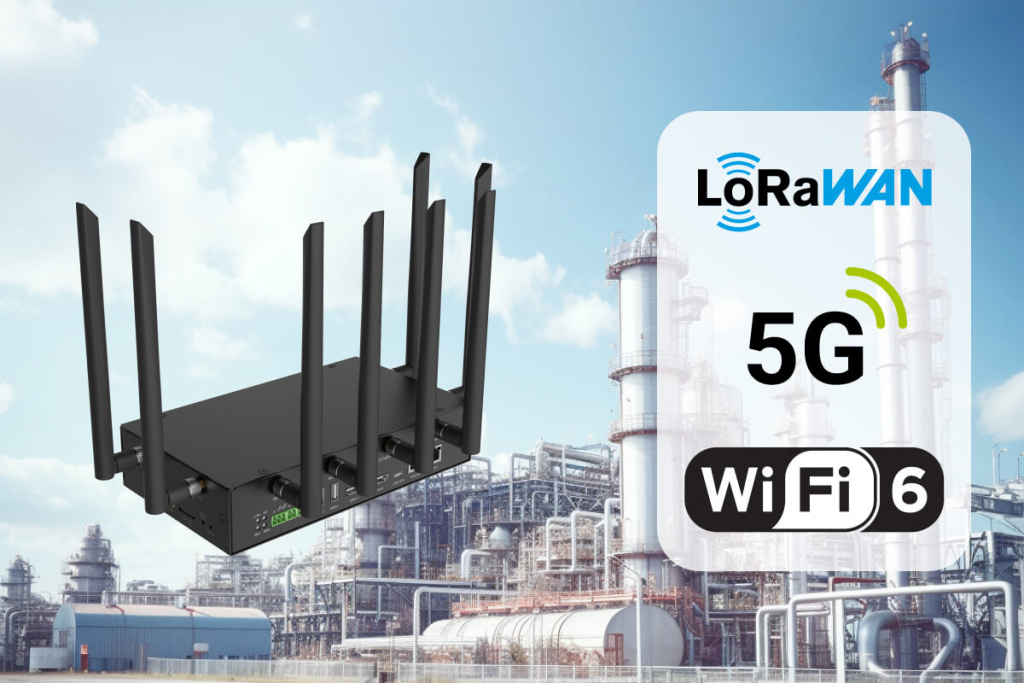What Is IoT In Oil and Gas Industry?
In the context of the oil and gas industry, IoT stands as a technology cornerstone. It encompasses an interconnected network of physical devices with remote sensors, edge computing gateways, the cloud, machine learning, and software solutions that are essential in collecting and exchanging data.
IoT in the oil and gas industry is multifaceted, extending from remotely monitoring and controlling a wide range of operational facets such as exploration, drilling, storage, supply chain tracking, and refining.
The implementation of IoT in the oil and gas industry allows for real-time data collection and remote tracking of equipment performance. This automates processes to sharpen decision-making and significantly boost operational efficiency.
IoT in Oil and Gas Market
According to Acumen research and consulting, the global IoT in oil and gas market size was valued at $11.2Billion in 20022 and is expected to grow at a CAGR of 9.7% during the forecast period (2024 to 2032), reaching $27.7Billions by 2032.
The growth of the IoT in oil and gas market is attributed to the following key drivers:
- The surging demand for enhancing operational efficiency and cost reduction;
- The rising requirements for predictive maintenance and real-time monitoring;
- The need to enhance regulatory compliance and worker safety (employee tracking in );
- Advancements in data analytics and sensor technologies;
- The decline in the availability of skilled labor and the surging threat of cyber-attacks in the oil and gas sector.
Read Case Study: Construction Site Employee Tracking
The size of IoT in oil and gas market is categorized based on the following segmentations:
- Application: (Fleet and Asset Management, Security Management, Preventive Maintenance, Pipeline Monitoring, Security Management, Others (Data Management and Hazardous Management). Asset management captured a significant share in the global IoT in oil and gas market in the previous years. It is also predicted to grow at the fastest CAGR between 2024 and 2032;
- IoT solution: (Sensing, Communication, Data Management, Cloud and Edge Computing, Communication, and Sensing). The Data Management segment acquired the largest share in the global IoT in oil and gas market in the previous few years;
- Geographical regions: (North America, Middle East & Africa, Europe, South America, Asia-Pacific). Asia-Pacific region led with over 38% of IoT in Oil and Gas Market share in 2022. However, the IoT in Oil and Gas Market growth in Middle East & Africa is expected to record a CAGR of over 10.1% from 2024 to 2032.
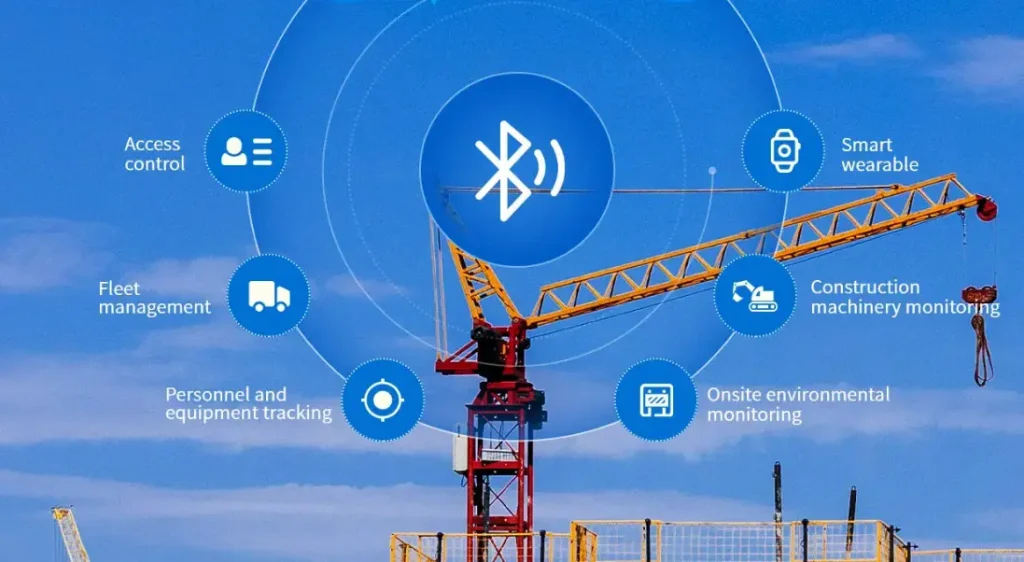
The key players in the IoT in oil and gas market include Microsoft Corporation, Intel Corporation, IBM Corporation, Alphabet Inc., CISCO Systems Inc., Amazon Web Services, Inc., C3 IoT, Inc., Siemens AG, Broadcom Inc.,Analog Device, Inc., Cognizant, and Wipro LTD.
Benefits of IoT in Oil and Gas Industry
Leveraging Internet of Things (IoT) technology in the Oil & Gas sector comes with numerous benefits, including:
- Improved operational efficiency: IoT sensors and smart gateways can monitor equipment performance in real time, allowing for predictive maintenance and minimizing downtime. This leads to increased productivity and optimized operations.
- Hazard management: IoT devices and technologies can detect and alert operators to potential hazards such as gas leaks, equipment malfunctions, or unsafe working conditions. This allows for prompt response to minimize risks to personnel and the environment.
- Reduced maintenance costs: Predictive maintenance powered by IoT sensors can identify potential equipment issues before they escalate. This reduces the need for costly downtime and emergency repairs, and extends the lifespan of equipment.
- Better decision-making: IoT-generated data provides valuable insights into operations. This allows oil and gas companies to make data-driven decisions and strategic planning based on real-time information.
- Advanced analytics: IoT data can be analyzed using advanced analytics techniques such as machine learning and artificial intelligence to identify trends, patterns, and anomalies. This optimizes processes and uncover hidden opportunities for efficiency improvements.
- Smart inventory management: IoT sensors and devices, such as BLE Beacons can track and manage the location and condition of equipment, materials, and products in real-time. This enables oil and gas companies to optimize inventory levels, reduce stock-outs or overstocks, and streamline supply chain operations.
How IoT Works in Oil and Gas Industry
Here is how IoT works in the oil and gas industry, broken down into various stages:

Stage 1: Sensor Integration
IoT devices are deployed throughout oil and gas facilities to collect various types of data such as temperature, pressure, flow rate, vibration, gas composition, etc.
These smart sensors can be placed on equipment such as pumps, pipelines, valves, and tanks.
Stage 2: Data Transmission
The data collected by sensors is transmitted using various communication protocols (gateways) such as Wi-Fi, Bluetooth, Zigbee, or cellular networks (2G, 3G, 4G, or even emerging technologies like NB-IoT or LTE-M).
Get to know: What is an IoT gateway?
The choice of protocol depends on various factors, such as the following:
- The need for real-time communication
- Data volume
- The distance between sensors
Stage 3: Data Aggregation and Protocol Conversion
Data from different sensors and devices are aggregated and processed to prepare them for transmission to the cloud.
This may involve converting data formats, normalizing data, and performing basic analytics at the edge to reduce the volume of data transmitted and optimize bandwidth usage.
Stage 4: Sending Data to the Cloud:
The aggregated and processed data is sent to cloud-based platforms for storage, analysis, and further processing. Cloud platforms provide scalability, flexibility, and advanced analytics capabilities. This allows oil and gas companies to derive valuable insights from the vast amount of data collected.
Stage 5: Visualization:
Data collected from sensors are visualized through dashboards and reports, providing operators and decision-makers with real-time insights into the performance of equipment and processes.
Visualization tools help in monitoring asset health, detecting anomalies, and identifying potential issues before they escalate into major problems.
Stage 6: Alerts and Alarms:
IoT systems in the oil and gas industry are equipped with alerting mechanisms that notify operators and maintenance teams about critical events or anomalies detected in the data. These alerts and alarms can be configured based on predefined thresholds or through machine learning algorithms that analyze historical data to predict failures or performance degradation.
Connectivity Technologies Used for IoT in Oil & Gas Industry
Here are the three major connectivity technologies utilized to enable IoT deployments across vast and often remote facilities in the oil and gas industry:
- LoRaWAN: LoRaWAN is deployed for remote monitoring of equipment such as pipelines and tanks due to its long-range capability and low power consumption. It is ideal for low-power applications and remote areas within the oil and gas company.
- Cellular LTE 4/5G: Cellular LTE 4/5G is utilized for real-time data transmission in applications such as remote asset monitoring, video surveillance, and workforce management across oil and gas facilities. It is ideal for reliable, high-speed, and wide-area coverage applications, such as real-time monitoring and control applications in the oil and gas sector.
- Ethernet: Ethernet is local area network (LAN) connectivity employed within refineries and processing plants. It is ideal for stable, high-bandwidth local connections. In the oil and gas industry, Ethernet is often used for connecting sensors, controllers, and other IoT devices to local networks, data acquisition systems, and control systems.
IoT Devices Used in Oil and Gas Industry
When it comes to IoT devices used in the oil and gas industry, explosion-proof sensors, gateways or Data Transfer Units (DTUs), and edge computing devices are essential components. Here is a breakdown of each:
Gateway/DTU (Data Transfer Unit)
- Wireless Sensor Gateways: Act as communication hubs to aggregate data from sensors deployed across the oil and gas site. They utilize protocols like Zigbee or LoRaWAN for communication. We have a list of 10 wireless sensor gateway technologies that are commonly used in IoT in the oil and gas industry.
- Cellular DTUs: Transmit sensor data over cellular networks, enabling connectivity in remote locations where wired connections are impractical. They often feature ruggedized designs and certifications for use in hazardous environments. We designed IoT cellular DTUs that are used in the oil and gas industry.
- Ethernet Gateways: Aggregate data from sensors and transmit it to central servers or cloud platforms over Ethernet connections, suitable for sites with existing infrastructure.
Best Gateways for IoT in oil and gas industry applications
Selecting the best gateway is essential for flawless connectivity and reliable data transmission. Here we recommend that DSGW-380, DSGW-014, and DSGW-006 are optimal choices for IoT in oil and gas industry applications.
DSGW-380 Industrial Edge AI Gateway Supporting Machine Learning, with 5G & WiFi6 Capabilities as well as Two Ethernet Ports
DSGW-380 is a highly scalable, rugged edge computing gateway designed to provide accurate data collection and accommodate high flow rates for oil and gas industrial applications. This gateway can gather data from thousands of devices and transmit it over kilometers away. It also supports a wide range of features including the following:
- IoT wireless protocols, such as LoRaWAN and BLE 5.2;
- Wi-Fi 6 (IEEE 802.11ax);
- Cellular 5G, 4G LTE CAT1 and CAT4;
- Various industrial real-time fieldbus and Ethernet protocols;
- ROS robot system;
- Various deep learning framework software, such as Caffe, PyTorch, MxNet, and Tensor;
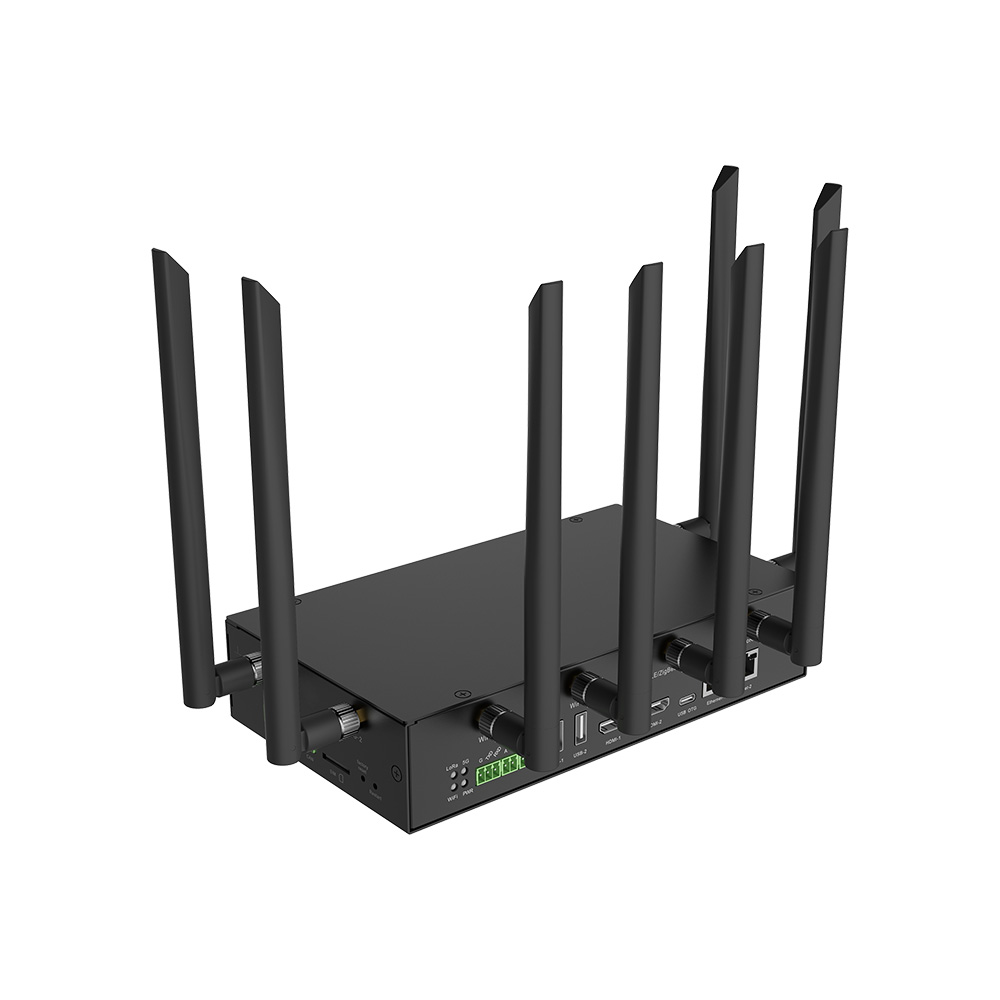
DSGW-014 IP66 Outdoor LoRaWAN Gateway with GPS Function
DSGW-014 is a versatile outdoor LoRa Transmitter that supports DC power supply and PoE (Power over Ethernet) options.
It is designed to handle hundreds of protocols, including LTE Cat1/Cat M1, LoRa, BLE 5.2, and Wi-Fi 2.4G. It also supports local deployment with public LoRaWAN Network Services, including Chirpstack and The Things Stack. All this makes DSGW-014 a perfect option for IoT application and scenarios in the oil and gas industry.
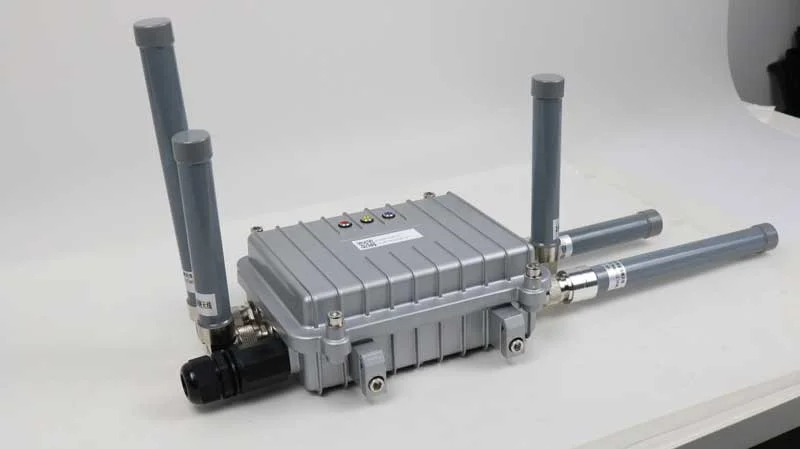
DSGW-006 Indsutrial Router Gateway with Two RS485 COM Ports
DSGW-006 is specially designed for applications in Automation and Smart Manufacturing, making it an ideal option for deployment in the oil and gas industry. It supports a vast range of protocols, including Wi-Fi 2.4G, LTE Cat4, MQTT, and Modbus.
It seamlessly integrates with popular public platforms, such as AWS IoT edge computing and ThingsBoard IoT, providing reliable and secure edge-to-cloud connectivity for IoT applications in oil and gas industry.
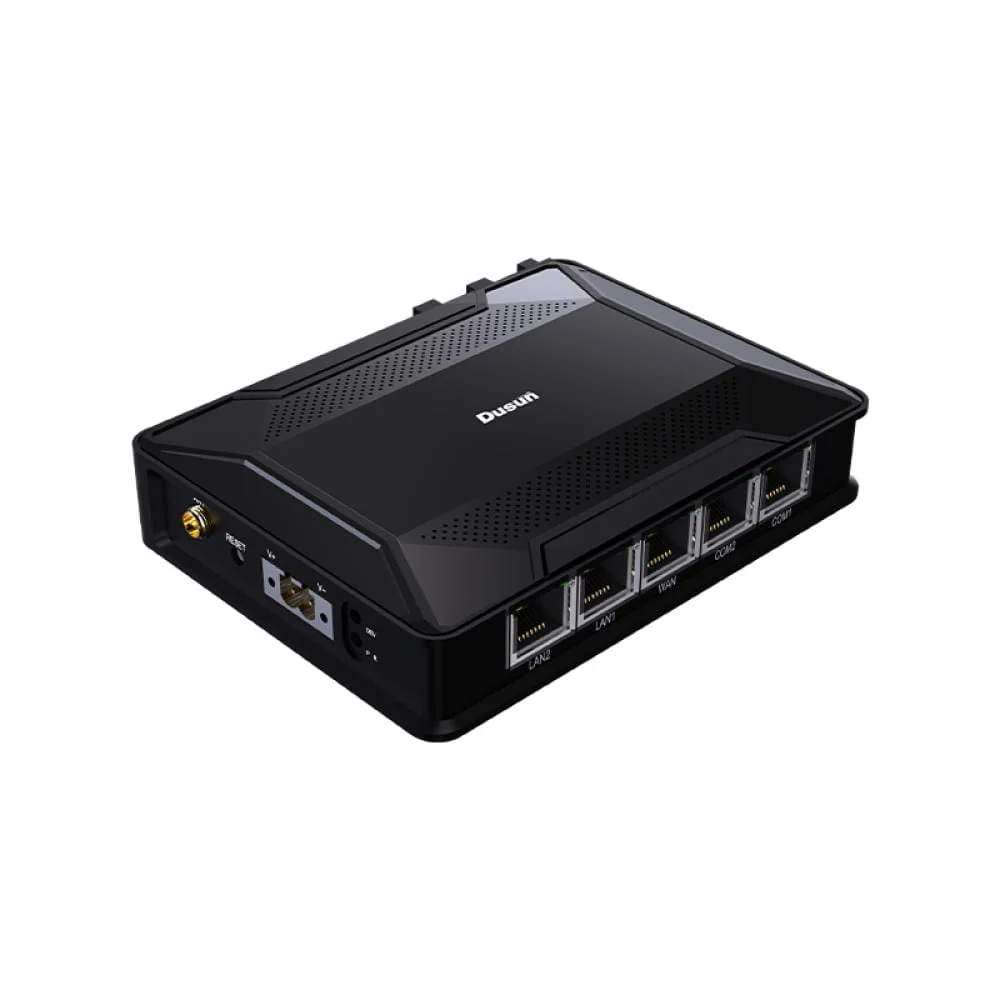
Explosion-Proof Sensors
- Temperature Sensors: Monitor temperature variations in critical equipment and facilities to prevent overheating and potential hazards.
- Gas Detectors: Detect and monitor the presence of hazardous gasses such as methane, hydrogen sulfide, and volatile organic compounds to prevent accidents and ensure worker safety.
- Pressure Sensors: Used for monitoring pressure levels in pipelines, wellheads, and equipment to prevent leaks and ensure operational safety.
- Level Sensors: Monitor liquid levels in tanks, vessels, and pipelines to prevent spills and ensure optimal operational efficiency.
Welcome to develop and manufacture explosion-proof smart sensors that are commonly used in oil and gas industry with Dusun IoT.
Edge Computing Devices
- Edge Gateways: These devices process and analyze data collected from sensors at the edge of the network, allowing for real-time decision-making without relying solely on centralized servers or cloud platforms. They can run analytics algorithms to detect anomalies or predict equipment failures, enhancing operational efficiency and reducing downtime.
- Edge Servers: Deployed at the edge of the network, these servers store and process data locally, reducing latency and ensuring continuous operation even in the event of connectivity issues with central servers or the cloud. They are essential for applications requiring real-time processing or compliance with data privacy regulations.
IoT Applications in Oil and Gas Industry
IoT (Internet of Things) applications have been increasingly utilized across the oil and gas industry to enhance efficiency, safety, and productivity. Here is an explanation of the mentioned applications in different aspects of the oil and gas sector:
IoT Applications in Oil & Gas Exploration and Production:
- Seismic data acquisition and analysis: IoT sensors can be deployed across exploration sites to collect seismic data in real-time, allowing for more accurate analysis of underground formations and potential drilling locations.
- Drilling optimization: IoT devices installed on drilling equipment can monitor parameters such as pressure, temperature, and drilling speed, enabling real-time adjustments to optimize the drilling process and reduce costs.
- Production monitoring and optimization: IoT sensors installed on production equipment can monitor production rates, equipment performance, and environmental conditions, allowing operators to optimize production processes and identify potential issues proactively.
IoT Applications in Pipeline Monitoring and Maintenance:
- Leak detection and prevention: IoT sensors deployed along pipelines can detect changes in pressure, flow rate, and temperature, signaling potential leaks or ruptures. This enables operators to take immediate action to prevent environmental damage and minimize downtime.
- Pipeline integrity management: IoT devices can continuously monitor the structural integrity of pipelines, detecting signs of corrosion, erosion, or mechanical damage. This proactive approach helps prevent pipeline failures and ensures the safe transportation of oil and gas.
- Energy consumption optimization: IoT sensors can monitor energy usage along the pipeline network, identifying areas of inefficiency and enabling operators to optimize energy consumption for pumping and other operations.
IoT Applications in Refining and Processing:
- Process optimization and control: IoT sensors integrated into refining and processing equipment can monitor variables such as temperature, pressure, and chemical composition in real-time, allowing for precise control and optimization of refining processes to improve efficiency and reduce waste.
- Equipment monitoring and predictive maintenance: IoT devices can monitor the health and performance of refining equipment, predicting potential failures based on data analysis and enabling proactive maintenance to prevent costly downtime.
- Safety and environmental monitoring: IoT sensors can monitor environmental factors such as air quality, emissions, and chemical leaks in refineries, ensuring compliance with safety regulations and minimizing environmental impact.
IoT Applications in Oil and Gas Logistics and Distribution:
- Fleet and asset tracking: IoT devices installed on vehicles, ships, and equipment can provide real-time tracking and monitoring of assets throughout the supply chain, improving logistics efficiency and asset utilization.
- Remote monitoring of storage facilities: IoT sensors can monitor storage tank levels, temperatures, and other critical parameters remotely, enabling operators to optimize inventory management, prevent stockouts, and ensure compliance with safety regulations.
- Smart metering and billing: IoT-enabled meters can accurately measure and monitor oil and gas consumption at distribution points, allowing for automated billing processes and providing customers with real-time usage data for better resource management.
Challenges of Implementing IoT in Oil and Gas Industry
As mentioned above, integrating IoT in the oil and gas industry comes with a vast range of benefits. However, Implementing IoT (Internet of Things) in the oil and gas industry comes with several challenges:
Data security and privacy concerns
IoT devices and systems generate, collect, transmit, and store massive amounts of data, much of which is sensitive and critical to the industry operations. Ensuring robust cybersecurity and privacy measures and addressing potential vulnerabilities in IoT networks is paramount, as any breach could have significant financial, operational, and even safety implications.
Integration with existing systems
Oil and gas companies typically have complex and legacy systems in place. Integrating IoT devices and data streams with these existing systems can be challenging, can be complex, and time-consuming. This is because integrating IoT with existing oil and gas systems entails substantial modifications or upgrades to ensure seamless interoperability. This requires a clear understanding of the existing systems and a well-thought-out implementation plan.
High initial investment costs
Deploying IoT solutions in the oil and gas industry often requires significant upfront investments. This includes the costs associated with acquiring and installing IoT sensors, establishing connectivity, and implementing supporting infrastructure like data storage and analytics platforms.
Therefore, oil and gas companies must carefully evaluate IoT’s potential long-term benefits and return to investment (ROI) before committing to adopt it.
Talent and skill gaps
Implementing and managing IoT systems and solutions requires a skilled workforce proficient in areas such as data analytics, cybersecurity, and IoT device management. However, as the IoT market continues to grow rapidly, there is often an increasing shortage of talent with the necessary expertise in these specialized fields. This makes it challenging for oil and gas companies to effectively deploy and maintain IoT initiatives.
Top IoT Use Cases In Oil And Gas Industry
There are many IoT in the oil and gas industry use cases that already work at various stages of the supply chain. Here are some real-life examples that show show the practical applications of IoT in oil and gas industry:
Shell
In 2021, Shell partnered with HiberHilo, an end-to-end IoT startup, to provide data-driven well monitoring solutions globally. Shell utilizes this IoT technology to measure real-time pressure and temperature on unconnected wells in offshore and remote locations.
Besides, Shell chose the C3 IoT platform for a wide range of AI applications, such as predictive maintenance. Through this move, Shell has accelerated digital transformation and enhanced the scope of its advanced analytics capabilities.
Saudi Aramco
Honeywell and Saudi Aramco signed a deal in 2017 to further support the diversification and development of Saudi Arabia’s oil and gas industry. They aimed at accelerating the benefits of IoT within Saudi Aramco’s operations through cloud-based solutions and predictive analytics.
Chevron
With the help of Microsoft Corp.’s IoT services, Chevron can monitor the health of different equipment and ensure predictive maintenance to address issues in its oil fields and refineries. By 2024, Chevron aims to have sensors connected to much of the critical equipment to predict the exact time of equipment servicing.
Future trends of IoT in Oil and Gas Industry
The future of IoT in the oil and gas industry is marked by several transformative trends poised to revolutionize operations, safety, and efficiency in the oil and gas sector:
- AI algorithms: It will enable predictive maintenance, optimizing equipment performance and reducing downtime.
- Edge computing: It will process data closer to its source, enhancing real-time decision-making and reducing latency.
- 5G connectivity: It will support faster and more reliable communication between devices, enabling seamless integration and data exchange across vast operations.
- Digital twins: The virtual replicas of physical assets, will revolutionize asset management by providing accurate simulations for predictive analysis and optimization.
- Cybersecurity Solutions: Upcoming IoT technologies will include more advanced cybersecurity measures, such as AI-driven threat detection and encryption protocols, to safeguard critical infrastructure and data.
Final Word
Do you work in the oil and gas industry? Interested in IoT solutions for the oil and gas industry? Or looking for experts who could explain IoT in the oil and gas industry and help you find the optimal solution for your needs? Or simply exploring technologies that could help you improve operations in your oil and gas industry?
Contact DusunIoT to learn more about the IoT hardware development services we offer for the oil and gas industry. We design IoT devices including indsutrial gateway, DTU, edge computing devices, and sensors according to your requirement. You could give us your specifications, and we can evaluate it and hold a meeting to discuss details.
We are an expert in LoRa connectivity and industrial IoT device manufacturing, we have a stable supply chain and multiple SoMs as well as programmable IoT gateways with performance equivalent to multiple raspberry pi SBCs. Anyway, welcome to find us for your custom hardware solutions.









